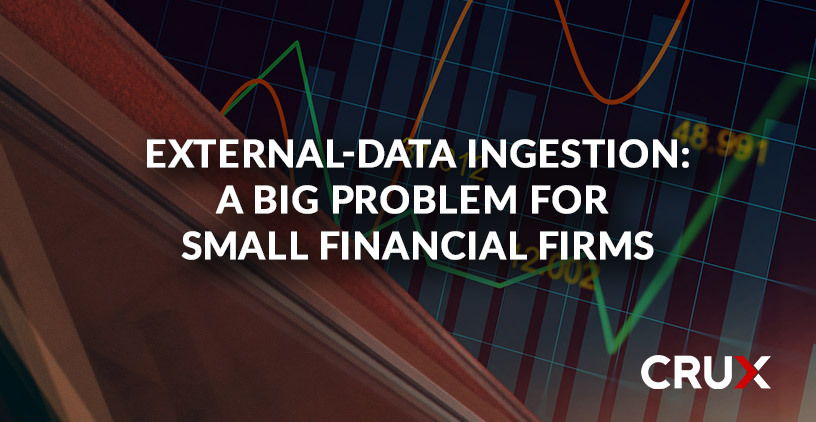What Cloud Marketplaces Do and Don’t Do
Not long ago, we observed here in our blog that the critical insights that drive business value come from data that is both (1) fast and (2) reliable.
4 min read
![]() Crux
Feb 18, 2020
Crux
Feb 18, 2020


Crux’s mission is to help data flow efficiently between data suppliers and data consumers, and we look to highlight major trends and developments impacting both parties. Today’s spotlight features EDI. Our Q&A was conducted with Jonathan Bloch, CEO.

Exchange Data International (EDI), founded in 1994, is a global provider of corporate actions, reference data and end of day prices for global equities, fixed income, listed and OTC derivatives.
The cornerstone of our success lies in our expertise in integrating, aggregating and the flexibility in delivering structured data to facilitate investment research, administration and processing as well as our ability to fit our clients’ operational requirements.
EDI covers reference, corporate actions and end of day pricing data which is available for equities, exchange traded funds and derivatives.
EDI provides corporate action and reference data to financial institutions worldwide including hedge funds, brokerage firms, market data vendors, front end trading platforms, middle and back offices systems and quant firms. These firms use our data to monitor changes in securities based on events that will impact those securities, providing an accurate inventory of listed securities worldwide.
Our clients are Hedge Funds, Fund Administrators, Index Providers and Service Providers:
EDI’s key product offerings continue to be corporate actions, reference data and end of day prices. We started with covering equities in 2005 and added fixed income in 2007. EDI began coverage of listed and OTC derivatives in 2017. Our goal is to cover all potential asset classes and we are looking to begin coverage for municipals, structured securities, including ABS/MBS, and non-US mutual funds by the third quarter of 2020.
EDI’s Corporate Actions cover events that will impact listed securities worldwide. Examples include mergers, stock splits, spin-offs, name changes, new listings/de-listings, etc. EDI covers Worldwide Corporate Actions including dividends on all equities worldwide. This is available in proprietary format, as well as ISO 1502 format.
As these events impact our clients’ portfolios, we provide timely updates on announcements and subsequent changes. This includes key data like effective dates so the investment community can update their systems and share timely information to their clients. Our corporate action service covers all global equity and fixed income markets dating back to 2007.
EDI also has a service that provides corporate action updates for listed options based on the underlying equity corporate action event that will impact that option contract.
EDI’s security reference data feed includes all of the typical identifiers like ISINs, Sedols, FIGIs/Bloomberg symbols, exchange tickers and US code and is updated four times a day based upon the closing of the US, European and Asian Pacific marketplaces.
This service currently covers equities, fixed income, options and futures worldwide. EDI also offers a Security Reference file which covers all the major codes/Symbols, such as SEDOLs, ISINS, Bloomberg Open FIGI, CUSIP.
EDI’s end of day prices are available by exchange or by a portfolio of securities.
This service is available within hours of the close of global exchanges. For certain markets, including the US, EDI provides an unconfirmed file which is available within 30 minutes after the close of the market.
Adjusted Closing Prices compare historical pricing data with current prices and conduct detailed analysis with either Adjusted Closing Prices or adjustment factors data feeds.
End of Day Pricing Data covers over 170 exchanges worldwide providing clients with quick access to extensive and accurate closing pricing data.
EDI’s adjustment factors file is used by our clients to adjust historical prices based on corporate action events that would create wide variations in price if not adjusted to account for the corporate action event.
This allows clients to compare historical trading patterns and run trading analytics based on corporate actions events. These files are delivered at the end of each day within hours of the close for all global equities exchanges and reflect events that impact securities like spin-offs, dividends and stock splits on the effective date of that event.
EDI’s evaluated pricing service covers 2.7 million global fixed income securities daily including corporates, governments, government agencies, municipals, ABS/MBS securities.
The biggest problem for financial institutions today is integrating data feeds. Not only does every data feed require a different loader, but feeds also need to be matched to existing data feeds.
The challenges are threefold;
A trend we’re seeing is that the consolidation within the industry is forcing clients to use big data providers whose fees continue to increase. Exchanges continue to increase fees and add excessive royalty fees for redistribution. We see increased interest from clients in taking new and different data feeds in the face of these increasing fees for traditional feeds.
We also see an increased interest in APIs. As the sheer volume of data increases, clients only want to receive what they require.
EDI is focused on adding complete coverage of all asset classes, looking to cover municipals, ABS/MBS and non US mutual funds by the end of 2020. We are looking at different ways of delivering data including adding an API for all of our datasets. We continue to see growth in the North American markets which now accounts for over 70% of our revenues.
We are looking to increase our sales presence in North America and open operations in Europe and the Far East in the future.
To receive these updates, join our community.

Not long ago, we observed here in our blog that the critical insights that drive business value come from data that is both (1) fast and (2) reliable.

This past year has been exciting, representing the dawning of a new age for artificial intelligence (AI) and machine learning (ML)—with large...

How do you get white-glove customer service from a major data supplier?